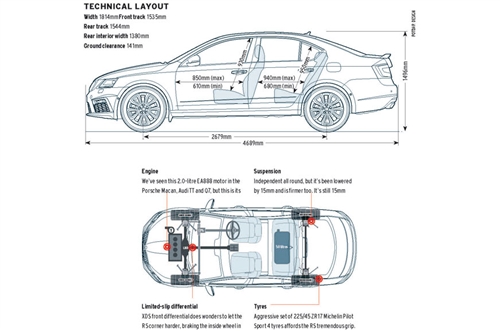
Affordable performance cars are finally catching on, and it’s important to remember that one of the pioneers of this sub-segment was the Octavia RS. We’ve had both the previous Octavias (second one was known as the Laura) and both came with RS variants. This meant sporty body kits, retuned suspension, better brakes, stylish wheels and wild colours, which caught on like wildfire with enthusiasts. However, there was a caveat – Indian RS models never got the ‘proper’ engine. The first car’s 1.8-litre TSI made significantly less power than its European counterpart, while the second car just used the 1.8 of the standard TSI variant rather than the then-new 2.0. And though the suspension was stiffened, it was just a basic retuning of the dampers. This time, though, it’s the proper Euro-spec 2.0 TSI motor with the proper output.
The engine in question is the 1,984cc version of the VW Group’s EA888 four-cylinder, direct-injection, turbo-petrol motor. We’ve seen it before in the Audi TT, which, like the Octavia, is built on the VW Group’s MQB modular platform that uses transversely mounted engines with front-wheel drive. Here, the engine produces 230hp at 5,500-6,200rpm and 350Nm of torque at 1,500-4,500rpm, sent through a six-speed DSG dual-clutch automatic gearbox, and then through an XDS limited-slip differential to the front wheels. In Europe, there is the option of a manual gearbox and even a diesel engine, but neither is offered here.
Suspension, like with the Octavia 1.8 TSI, is independent all round – a MacPherson strut setup at the front and a multi-link setup at the rear. However, the RS has, of course, been stiffened up. It’s also been lowered by 15mm compared to the standard car, but it’s still about 15mm higher than the European RS. The other key difference is that the Indian car runs on 17-inch alloy wheels, which is an inch bigger than the standard Indian Octavia but is the smallest available size on the European RS that goes all the way up to 20 inches. And finally, one of the most serious testaments to its performance credentials are the tyres – a set of rather specialised Michelin Pilot Sports, measuring 225/45 ZR17 all round. The ‘Z’ implies they can handle upwards of 240kph, which they’d need to, with the RS’ electronically limited top speed of 250kph.
Of course, all the changes from the 2017 facelift of the Octavia have been carried over, most notably the new nose with its quad-headlamp setup. It looks more convincing on the RS as the internals of the headlamps are finished in black, making the ‘inner’ lamps look like an extension of the grille itself. The tail-lamps too have a smoked effect and, apart from that, you get an aggressive front bumper, a sportier rear bumper with dual exhausts and a boot-lid spoiler. What’s also on offer is the generous equipment list of the top-spec Style Plus Octavia, which includes a sunroof, keyless entry and go, adaptive LED headlamps, powered front seats with a memory function for the driver, eight airbags, hands-free parking assist and a super-slick 8.0-inch touchscreen with navigation, Android Auto and Apple CarPlay. A welcome addition, given the high-performance petrol motor, is engine stop-start.
Practicality is one of the Octavia’s greatest strengths and that stays unchanged here. You still get a massive 590-litre liftback boot that can expand to 1,585 litres with the rear seats folded. The rear seat is still placed a tad low and thigh support could have been better, but the space on offer is just massive. The difference here is that the colour scheme is all black, the seats are wrapped in sporty Alcantara, there are big ‘RS’ logos on the seats and red stitching just about everywhere, all of which really suits the performance ethos. The front chairs are really special; a set of generously bolstered sports seats that are comfortable and supportive at the same time. And finally, it gets the flat-bottomed RS steering wheel, with perforated leather grip points that feel great at your fingertips.
Two other omissions, compared to the European car, are adjustable dampers and drive modes, but they would have only driven the cost up. And, as it turns out, the RS is still great to drive as is. You can change the powertrain’s characteristics, like all automatic VW Group cars, by tapping the gear selector downward to select ‘S’. But while in most of those cars the change is incremental at best, in the Octavia RS, it’s like driving an entirely different car. In regular ‘D’ mode, it feels no different to an Octavia 1.8 TSI. Before 2,000rpm, shifts happen smoothly and gently, and you can barely hear the engine or exhaust. Annoyingly, as ever, the DSG does tend to hesitate quite a bit before kicking down a gear when you want a sudden burst of acceleration. Still, this is the mode you would want to use for the daily grind.
Set it to ‘S’ and you’ll really feel the RS come alive. This locks the engine in its strong mid-range, which means it almost never drops below 2,000rpm. Coincidentally, it’s somewhere between 2,000 and 3,000rpm that the sports exhausts let out a lovely snarl. It’s not too loud, but is raspy and aggressive – more so from the outside than in – with a delightful ‘braap’ sound on the overrun. The acceleration isn’t neck-snappingly quick, but it just pulls and pulls. We managed to crack 100kph in just 6.6sec – which is 0.2sec quicker than Skoda’s own claim – using the easy-to-use launch control system, and with a bit more road where that 250kph top speed would’ve been easily attained. In ‘S’, the shifts are a lot more aggressive and it revs all the way to a 6,000rpm redline. Put it in Manual and that limit climbs to 6,700rpm, although it won’t hold gears if you don’t shift up.
The real genius in the Octavia RS mix is the limited-slip differential. In a corner, not only does it let the outside wheel spin faster, it brakes the inside wheel for more aggressive turn-in and will even stabilise the car under power. It does a phenomenal job of quelling the understeer that’s typical of a front-wheel-drive car. And this one has 350Nm! Those grippy Michelin Pilot Sport 4 tyres also add to this, clinging onto the tarmac much better than any mainstream rubber you’ve ever tried. They do elicit a bit of noise in the cabin, but if you’re driving hard enough, it will be overwhelmed by the engine noise. Then there’s the lowered, stiffened suspension. It’s not firm enough to be called uncomfortable, and the 45-profile tyres have just enough sidewall to absorb sharp edges. Sure, it’s not as plush as a standard Octavia, but it’s not far off. In fact, on the highway, it feels much better tied down than the floaty 1.8 TSI. And in corners, the far tighter body control encourages you to push it a lot harder than you would dare push the standard car. Similarly, the steering is clearly a bit heavier now, but never to the point of being cumbersome.
Like other TSI motors, it’s your driving style that can make or break your fuel economy returns. Our instrumented tests were done in normal ‘D’ mode, with stop-start activated, and in an everyday, non-aggressive driving style; we recorded 7.22kpl in the city and 13.10kpl on the highway. However, while we were shooting and testing the car, we drove it hard in ‘S’ mode, and the numbers were far lower than those. Trouble is, this is an RS, and you will find yourself pushing it more often than not.
Verdict

Copyright (c) Autocar India. All rights reserved.
[“Source-autocarindia”]





